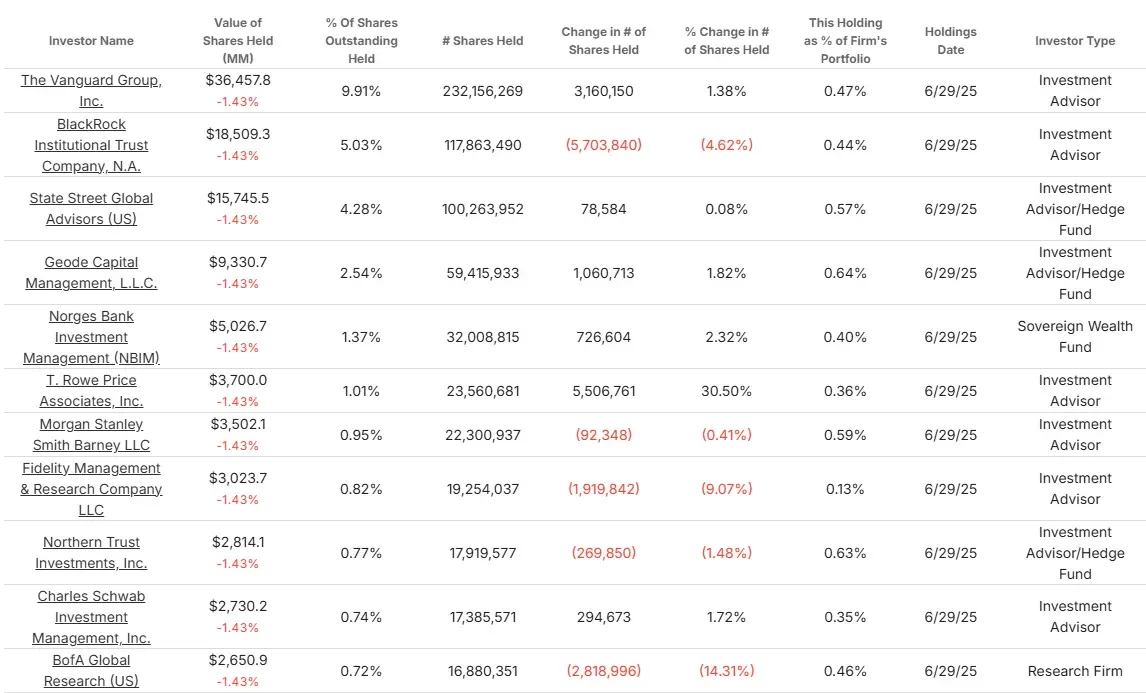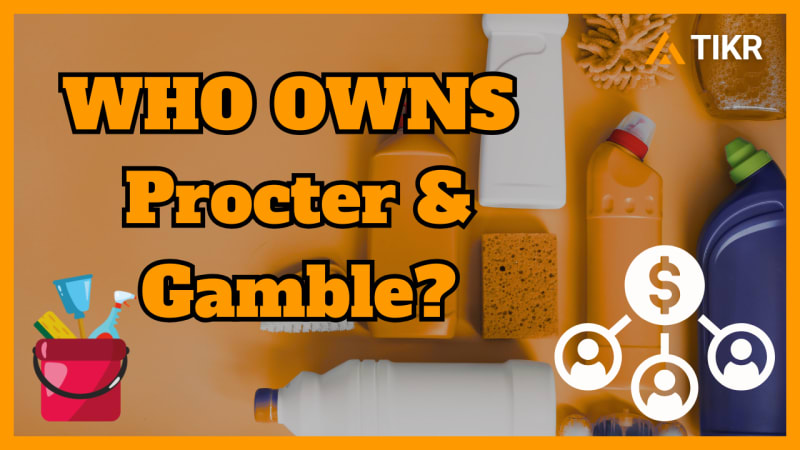Procter & Gamble (NYSE: PG) is a global consumer goods giant that makes everyday products across categories like fabric care, grooming, baby care, and oral care. The company has long stood as one of the world’s most iconic household names, recently trading around $157 per share with a market cap of about $368 billion.
From Tide and Gillette to Pampers and Crest, P&G’s brands reach billions of households worldwide, making it a cornerstone of everyday consumer spending. With gross margins above 50%, steady free cash flow, and a 2.7% dividend yield, the company has become a core holding for institutions seeking stability and income. While the stock has slipped about 7.6% in the past year, P&G’s scale, pricing power, and long record of dividend growth highlight its durability through shifting economic cycles.
Once closely tied to long-term retail ownership, P&G is now heavily dominated by global asset managers, sovereign funds, and retirement systems, reflecting its status as a defensive anchor in institutional portfolios.
Looking at who owns Procter & Gamble and how insiders are trading gives us a window into how the biggest players really feel about the stock today.
Who Are P&G’s Top Shareholders?

See whether Procter & Gamble’s top shareholders are buying or selling today >>>
Procter & Gamble makes consumer goods across categories like fabric care, grooming, baby care, and oral care, with brands that dominate shelves worldwide. Ownership of the company is dominated by large index funds, keeping PG closely tied to global equity flows. Alongside them, active managers made noticeable adjustments last quarter.
- Vanguard Group: 232.2M shares (9.9%), ~$36.5B. Added 3.16M (+1.4%).
- BlackRock: 117.9M shares (5.0%), ~$18.5B. Cut 5.7M (-4.6%).
- State Street: 100.3M shares (4.3%), ~$15.7B. Added slightly (+0.1%).
- Geode Capital: 59.4M shares (2.5%), ~$9.3B. Added 1.06M (+1.8%).
- Norges Bank: 32.0M shares (1.4%), ~$5.0B. Added 726K (+2.3%).
- T. Rowe Price: 23.6M shares (1.0%), ~$3.7B. Increased 5.5M (+30.5%).
- Morgan Stanley: 22.3M shares (1.0%), ~$3.5B. Trimmed 92K (-0.4%).
- Fidelity: 19.3M shares (0.8%), ~$3.0B. Cut 1.9M (-9.1%).
- Northern Trust: 17.9M shares (0.8%), ~$2.8B. Reduced 270K (-1.5%).
- Charles Schwab: 17.4M shares (0.7%), ~$2.7B. Added 295K (+1.7%).
- BofA Global Research: 16.9M shares (0.7%), ~$2.7B. Cut 2.8M (-14.3%).
One highlight from last quarter is Tudor Investment, led by Paul Tudor Jones, which raised its PG stake by more than 4,900% to about 229K shares worth $36 million. That kind of surge looks like a major tactical bet on P&G’s defensive strength.
Another notable move came from DE Shaw, run by David Shaw, which lifted its position by over 1,200% to 1.6M shares valued at roughly $260 million. For a systematic hedge fund, that jump suggests growing conviction in P&G’s cash flow stability.
Meanwhile, Two Sigma Advisers, managed by John Overdeck, boosted its holding by 1,200% to about 983K shares worth $156 million. Such a sharp increase may point to renewed confidence in P&G as a steady compounder.
Finally, Millennium Management, led by Israel Englander, expanded its stake by nearly 980% to 1.3M shares worth $208 million. That scale of buying signals a meaningful hedge fund vote of confidence in the stock’s resilience.
Index giants like Vanguard, BlackRock, and State Street keep P&G stable as a core portfolio holding. T. Rowe Price’s 30% increase looks like confidence in P&G’s long-term resilience, while reductions from BlackRock, Fidelity, and BofA may suggest some managers see limited upside near term.
Hedge fund inflows from Tudor, DE Shaw, Two Sigma, and Millennium add another layer of confidence, showing that fast-moving funds are positioning for stability.
Track the top shareholders of over 50,000 global stocks (It’s free) >>>
P&G’s Recent Insider Trades

Insider activity gives a peek into how company leaders may be managing their personal exposure. At Procter & Gamble, recent transactions have leaned toward selling rather than buying.
While insider sales can happen for many reasons that are not directly tied to business outlook, the broad participation of multiple executives makes the trend worth noting for investors.
Here are some recent insider sales:
- Jon Moeller (CEO): Sold ~40,100 shares at ~$157.
- Shailesh Jejurikar (Officer): Sold ~13,000 shares at ~$157.
- Marc Pritchard (Officer): Sold ~9,800 shares, later disclosed 18,900 shares held.
- Sundar Raman (Officer): Sold ~9,500 shares at ~$158.
- Andre Schulten (CFO): Sold ~11,600 shares at ~$157.
- Other officers, including Gary Coombe, Fatima Francisco, Jennifer Davis, and Susan Street Whaley, also reported sales.
The selling activity appears spread across the leadership team and may reflect diversification or pre-set trading plans. No major insider buying was reported, which could mean management is not rushing to add at today’s price levels.
While sales on their own do not necessarily signal weakness, the absence of insider buying may leave investors cautious about the stock’s near-term valuation.
See recent insider trade data for over 50,000 global stocks (It’s free) >>>
What the Ownership & Insider Trade Data Tell Us
Procter & Gamble remains a global portfolio staple, with ownership anchored by index giants like Vanguard, BlackRock, and State Street. That base of passive capital helps keep the stock steady, while active managers have shown mixed signals.
T. Rowe Price’s 30% increase looks like a strong expression of confidence, but reductions from Fidelity, BlackRock, and BofA suggest others may be less optimistic about near-term upside.
On the insider side, activity has leaned toward selling across multiple executives. These moves may simply reflect diversification or scheduled plans, but the absence of insider buying stands out. It could indicate that leadership does not view the current price as a clear bargain.
For investors, the takeaway is that P&G continues to look like a durable, dividend-paying compounder, yet both institutions and insiders appear cautious about committing more capital at current levels.
Wall Street Analysts Are Bullish on These 5 Undervalued Compounders With Market-Beating Potential
TIKR just released a new free report on 5 compounders that appear undervalued, have beaten the market in the past, and could continue to outperform on a 1-5 year timeline based on analysts’ estimates.
Inside, you’ll get a breakdown of 5 high-quality businesses with:
- Strong revenue growth and durable competitive advantages
- Attractive valuations based on forward earnings and expected earnings growth
- Long-term upside potential backed by analyst forecasts and TIKR’s valuation models
These are the kinds of stocks that can deliver massive long-term returns, especially if you catch them while they’re still trading at a discount.
Whether you’re a long-term investor or just looking for great businesses trading below fair value, this report will help you zero in on high-upside opportunities.
Click here to sign up for TIKR and get our full report on 5 undervalued compounders completely free.

